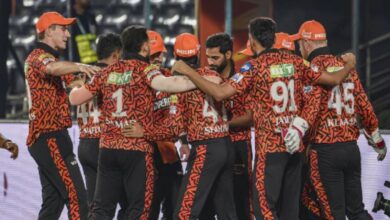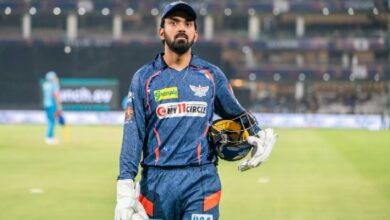Mihir Vasavda at Asian Games: Rowers from water-scarce Rajasthan amongst earliest medal winners in Hangzhou waters | Asian-games News

Only after he crossed the finish line did Arjun Lal Jat look around to soak in the scenery – the low-lying m covering the lush green mountain slopes, hanging over the prine waters of the Beizhi River, on which boats sailed.To his left, on the banks of the river, were the overflowing stands. On any other Sunday morning, the locals would’ve hiked up the Fushu range as they usually do. Today, they crammed into the bleachers that faced the mountains, overlooking the finish line.
This was a world far removed from the barren lands of Churu – nestled in the most rugged terrains of Rajasthan where mercury often crosses 50 degrees in summer – where Jat comes from. “I hadn’t even seen this much water before I joined the Army,” Jat, 23, says.
#AsianGames #HangzhouAsianGames
🥈 Arjun Lal Jat and Arvind Singh’s silver medal ceremony as India opened their accounts in rowing today in fine fashion.
🎥 Sony Sports pic.twitter.com/DTQlCXWqVR
— Express Sports (@IExpressSports) September 24, 2023
In the early hours of Sunday at the Fuyang Water Sports Centre, the man whose jaw dropped when he first saw a water body, paired up with Arvind Singh of Bulandshahr to win India’s first medal, a silver, of the Hangzhou Asian Games in one of the most gruelling water sports – rowing.
The duo completed the 2000m long lightweight doubles sculls in 6 minutes, 28.8 seconds to finish second behind the Chinese team that was faster half-a-boat length.
Minutes after India opened its account at these Games, the duo from Rajasthan – Lekh Ram and Babu Lal – combined to win the bronze medal in the coxless pairs race. And soon, another medal followed as India clinched the team silver in the coxed eight race, with three of the rowers hailing from remote Rajasthan villages, bringing the total medalls from the state on Day 1 to 6.
The rowing races marked the beginning of a frenetic morning on Day 1 of competition, where India and China were involved in multiple close duels all of which ended in the favour of the host nation.
Roughly a 20-minute drive away from the rowing venue, around the same time when Jat and Arvind sailed past the finish line, India’s women’s air rifle shooting team comprising Ramita Jindal, Mehuli Ghosh and Ashi Chouksey were beaten the Chinese in the gold-medal race. An hour later, Ramita finished behind two home favourites shooters to settle for an individual bronze in the same event.
Apart from the fact that many rowers are from Rajasthan, are Armymen and are among India’s earliest medal winners of these Asian Games, these athletes have one more thing in common – they are all accidental rowers.
India win first medal of the #HangzhouAsianGames. A silver in rowing, on the foothills of the beautiful m covered Fushu mountain range pic.twitter.com/URwGyUFqR1
— Mihir Vasavda (@mihirsv) September 24, 2023
“I think I can speak for all of us from Rajasthan that we did not know that a sport such as rowing even exed,” Jat, who belongs to a family of farmers, says.
Rowing, he adds, happened chance. Jat’s primary aim was to get into the Army and ‘secure’ his future. “It’s either that (joining the Army), or farming,” Jat says. “So, I put all my energy into getting picked for the Army. Sport was never on my radar.” It was only after he was picked for 14 Raj Rifles that the Army sports scouts spotted Jat.
The careers of all rowers from Rajasthan have followed a similar trajectory.
“When we mention Rajasthan, we immediately think of the desert,” says chief coach Ismail Baig. “We don’t associate the place with water sports and for a good reason. But the physique of the people from that belt suits the game. In my career, most of the players are from that region. Curiously, there isn’t a dedicated rowing centre there yet.”Most Read
1
Jawan box office collection day 17: Shah Rukh Khan’s blockbuster breaks Pathaan’s record, is the biggest Hindi movie of all time in India
2
How the Sikh migration to Canada began
See More
The physique that Baig, Indian rowing’s Dronacharya, refers to is defined on paper the Army, which provides maximum rowers to the national team. The athlete’s height has to be at least 183 cm with minimum weight of 70kg, a wing-span of 193 cm and leg length of 108 cm.
Col Ramakrishna, the Commanding Officer of the Army Rowing Node, says Army recruits from Rajasthan easily meet these parameters. “The bulk of our talent pool comes from Rajasthan, Punjab, Haryana and Western UP. These places don’t have water bodies as such. So they might not have been exposed to rowing but they have the perfect physique for it,” he says.
Jat was introduced to rowing Olympian Bajrang Lal Takhar, also from Rajasthan. He jokes about being afraid of water and the initial fears of his boat capsizing. “But I’ve overcome those anxieties now,” Jat says, flexing his right arm on which the Olympic rings are tattooed. “Those fears were because I had never seen anything like that. But now, I am ready to conquer the waters.”







